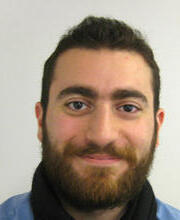Maurice Abou Jaoude
Department of Neurology, Massachusetts General Hospital
Project Title: Detection of Deep Interictal Epileptiform Discharges (IED) from scalp EEG

Project Summary: Epilepsy is one of the most common neurological chronic brain disorders, affecting nearly 50 million people globally. In the clinic, the most widely used evaluation for the diagnosis of epilepsy is the detection of interictal (between seizures) abnormalities on the scalp EEG, which are usually in the form of spikes known as Interictal Epileptiform Discharges (IED). However, the sensitivity of epilepsy diagnosis is low, and ranges, depending on the case, between 25% and 56%.
It has been shown that approximately 70% of IEDs that are apparent in EEG recorded from Foramen Ovale electrodes (FOe) are not obvious in concurrent recordings from the scalp, FOe being electrodes that are inserted through the foramen ovale in the skull and whose active sites lie next to mesial temporal structures.
The objective of this project is to determine whether by considering the timing information of the IEDs from FOe EEG, the resulting simultaneous scalp EEG contains enough information for the IEDs to be reliably distinguished from non-IED segments. This will be done using a combination of signal processing and machine learning techniques. This would serve as a biomarker for hippocampal activity and thus, among other consequences, improve the sensitivity of Epilepsy diagnosis.
Project Title (2): Development and Translation of PEDOT:PSS Microelectrodes for Intraoperative Monitoring
Poly(ethylenedioxythiophene) (PEDOT) is an electrically conducting polymer that emerged as a very promising material for neural interfaces because of its desirable characteristics such as low electrochemical impedance over the band of frequencies of interest, superior chemical stability, and biocompatibility.
The aim of this project is to develop PEFOT:poly(styrenesulfonate) (PSS) microelectrode arrays for reliable electrophysiological recordings in human subjects. Two types of devices, one for surface recordings and one for depth recordings, are currently being tested in patients undergoing brain-related surgeries in the Operating room. Once their use has been validated in this context, testing will be carried out on awake patients in human cognition studies.
